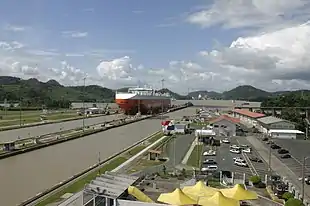This article is issued from Wikipedia. The text is licensed under Creative Commons - Attribution - Sharealike. Additional terms may apply for the media files.
Portal maintenance status: (June 2018)
|
 Introduction
Panama (/ˈpænəmɑː/ ⓘ PAN-ə-mah, /pænəˈmɑː/ pan-ə-MAH; Spanish: Panamá IPA: [panaˈma] ⓘ), officially the Republic of Panama (Spanish: República de Panamá), is a transcontinental country in Central America, spanning the southern tip of North America into the northern part of South America. It is bordered by Costa Rica to the west, Colombia to the southeast, the Caribbean Sea to the north, and the Pacific Ocean to the south. Its capital and largest city is Panama City, whose metropolitan area is home to nearly half the country's over 4 million inhabitants.0 Panama was inhabited by indigenous tribes before Spanish colonists arrived in the 16th century. It broke away from Spain in 1821 and joined the Republic of Gran Colombia, a union of Nueva Granada, Ecuador, and Venezuela. After Gran Colombia dissolved in 1831, Panama and Nueva Granada eventually became the Republic of Colombia. With the backing of the United States, Panama seceded from Colombia in 1903, allowing the construction of the Panama Canal to be completed by the United States Army Corps of Engineers between 1904 and 1914. The 1977 Torrijos–Carter Treaties agreed to transfer the canal from the United States to Panama on December 31, 1999. The surrounding territory was first returned in 1979. Revenue from canal tolls continues to represent a significant portion of Panama's GDP, although commerce, banking, and tourism are major and growing sectors. It is regarded as having a high-income economy. In 2019 Panama ranked 57th in the world in terms of the Human Development Index. In 2018, Panama was ranked the seventh-most competitive economy in Latin America, according to the World Economic Forum's Global Competitiveness Index. Panama was ranked 84th in the Global Innovation Index in 2023. Covering around 40 percent of its land area, Panama's jungles are home to an abundance of tropical plants and animals – some of them found nowhere else on earth. Panama is a founding member of the United Nations and other international organizations such as OAS, LAIA, G77, WHO, and NAM. (Full article...) Selected article - Miraflores Locks in 2004 The idea of the Panama Canal dates back to 1513, when Vasco Núñez de Balboa first crossed the Isthmus of Panama. This narrow land bridge between North and South America was a fine location to dig a water passage between the Atlantic and Pacific Oceans. The earliest European colonists recognized this, and several proposals for the construction of a canal were made. By the late nineteenth century, technological advances and commercial pressure allowed construction to begin in earnest. Noted canal engineer Ferdinand de Lesseps led the initial attempt by France to build a sea-level canal. Beset by cost overruns due to the severe underestimation of the difficulties in excavating the rugged terrain, heavy personnel losses to tropical diseases, and political corruption in France surrounding the financing of the massive project, the canal was only partly completed. (Full article...)CategoriesCategory puzzle Select [►] to view subcategories
Panama Panama-related lists Buildings and structures in Panama Panamanian culture Economy of Panama Education in Panama Environment of Panama Geography of Panama Government of Panama Health in Panama History of Panama Organizations based in Panama Panamanian people Politics of Panama Society of Panama Images of Panama Panama stubs General imagesThe following are images from various Panama-related articles on Wikipedia.
Selected image -
Did you know -
Panama listsRelated portalsPanama topics
Things you can do Here are some things you can do:
WikiProjectsWikiProject Central America
Associated WikimediaThe following Wikimedia Foundation sister projects provide more on this subject:
Discover Wikipedia using portals
| |||||||||||||||||||||||||||||||||||||||||||||||||||||||||||||||||||||||||||||||||||||||||||||||||||||||||||||||||||||||||||||||||||||||||||||||||||||||||||||||||||||||||||||||||||||||||||||